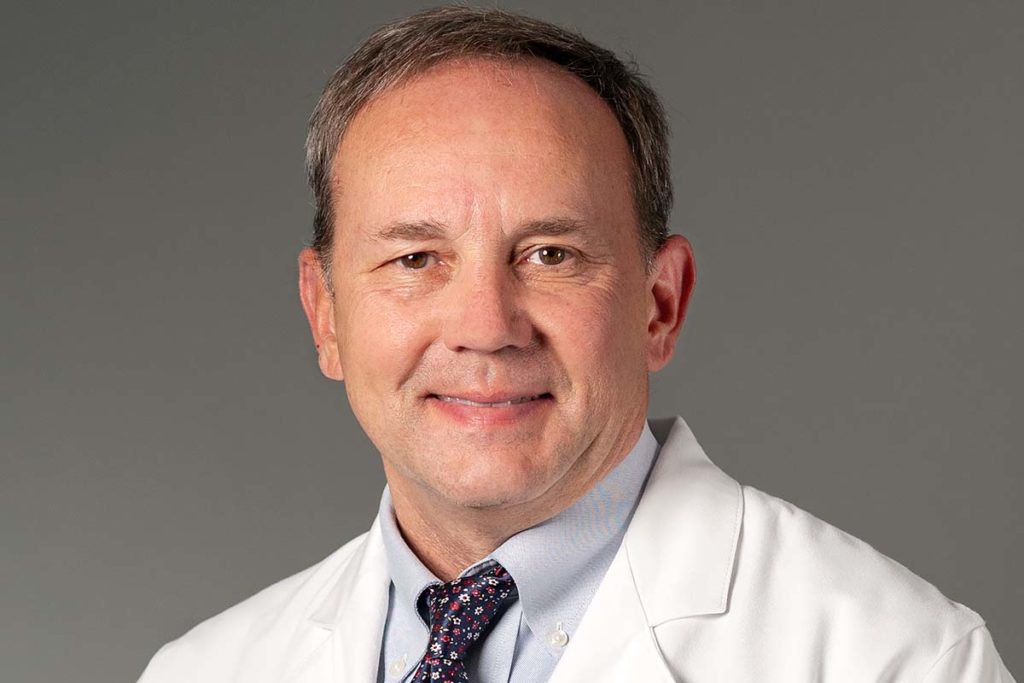A breast radiologist is an expert in breast imaging tools like mammograms and MRI that reveal cancer. Timothy Rooney, MD, specializes in:
- Breast MRI/fast breast MRI
- 3D mammograms
- Breast MRI-guided biopsy
Rooney’s patients are often extremely anxious about their breast cancer risk or symptoms. He enjoys connecting with them and tries to give them the best possible experience.
We asked him to answer our 7 Quick Questions.
Meet a UVA Breast Radiologist
1. Why did you become a doctor?
I thought about becoming a doctor for many years before I acted on it. I loved the mix of patient care and technology. So even though I was having a successful career flying in the Navy, I felt like I was called to medicine. I transitioned my emphasis, completed my prerequisites for medical school, applied and got in.
2. Why did you choose your specialty?
Radiology was a neat mix of forward-thinking medicine and caring for patients. In many ways, we’re a hub of many spokes within the hospital and in the outpatient setting. Pretty much everyone goes through imaging at some point.
That crossroads of technology and patient care, the robust ability to consult with other physicians, combined with a really great radiology department where I was training in the Navy, led me to radiology.
For breast radiology, specifically, I had an early exposure to this patient population during my residency. It was clear this was not what people typically envision for a radiologist; you aren’t hiding in a dark room. You are front and center, seeing patients and creatively managing their care. It’s a great opportunity to be part of a team.
3. What is your favorite thing about Charlottesville?
There are a lot of great things about Charlottesville. There’s an incredible number of great restaurants. It’s a beautiful, hilly town. When we came down from Dartmouth, we didn’t expect to be able to walk into the mountains from the backyard, but you can do that just as we did there. We’ve been to the Shenandoah and to the shore, so it’s in proximity to lots of cool stuff.
I’m also super excited about shoulder seasons. They didn’t exist in New Hampshire. It was summer for about five minutes and then winter again. So I’m looking forward to having a summer and a fall. I’m a rower, so rowing and not freezing all the time is really exciting for me.
The town itself is really cool. All of the great things about a university town are here.
4. Where did you grow up?
All over the place. My father was also military and was an airline pilot, so I grew up on both coasts. I was born in Salinas, California then went back and forth. By high school, I was back in New England. That’s where I went to high school and college.
5. What’s the most exciting thing happening in your field right now?
There is super exciting stuff going on with 3D mammography and digital mammography. We’ve made leaps and bounds with this technology.
There are things that are now ready for prime time, such as fast MRI and contrast-enhanced mammography, that provide better sensitivity and specificity. These will allow us to find a whole new reservoir of breast cancers that are not seen on a traditional breast mammogram.
6. Who is your inspiration or hero?
The person who comes to mind in the most substantial sense is the commanding officer of my fighter squadron. Hollywood has lots of stereotypes of military leadership, but he was a surprising example of thoughtful leadership.
I was a young fighter pilot and my squadron was crossing the Atlantic in a huge storm. This is when I was first exposed to the customer-based leadership model. It’s not a top-down approach. It’s using a team concept, relying on others, lifting others up.
To this day, I remember, he launched my leadership style and I haven’t varied from that since. He was an amazing advocate of that leadership philosophy. I was able to work through that with him in a real environment with a bunch of underpaid sailors on deployment on a carrier in the middle of nowhere.
Get a Breast Cancer Screening
Our experts will make sure you get the right type of screening for your risk level and needs.
7. What’s your favorite thing about working at UVA?
I think it’s really cool that the six of us faculty here in the breast imaging department really are on the same playing field. We have the ability to ask tough questions, to put ourselves out there, to be vulnerable and maintain that mutual respect. It’s noticeable. I really have to give credit to my colleagues and also the interim director and division head, Dr. Carrie Rochman, who really has done such a great job and presents that personal approach. For me, that meant I was welcomed with open arms. That is not something everyone can count on.
Our chairman is amazing; he fosters that collegial attitude.
